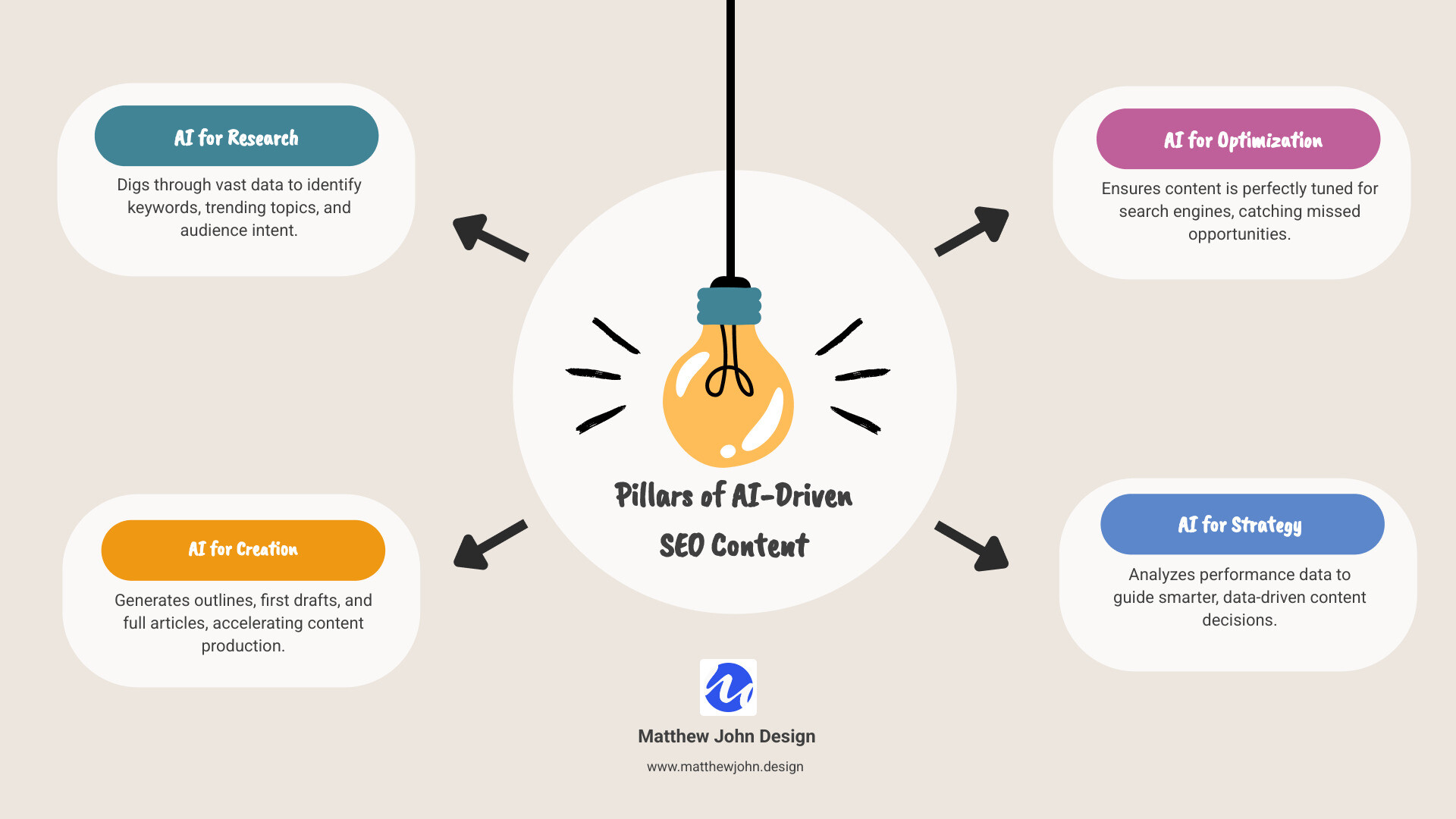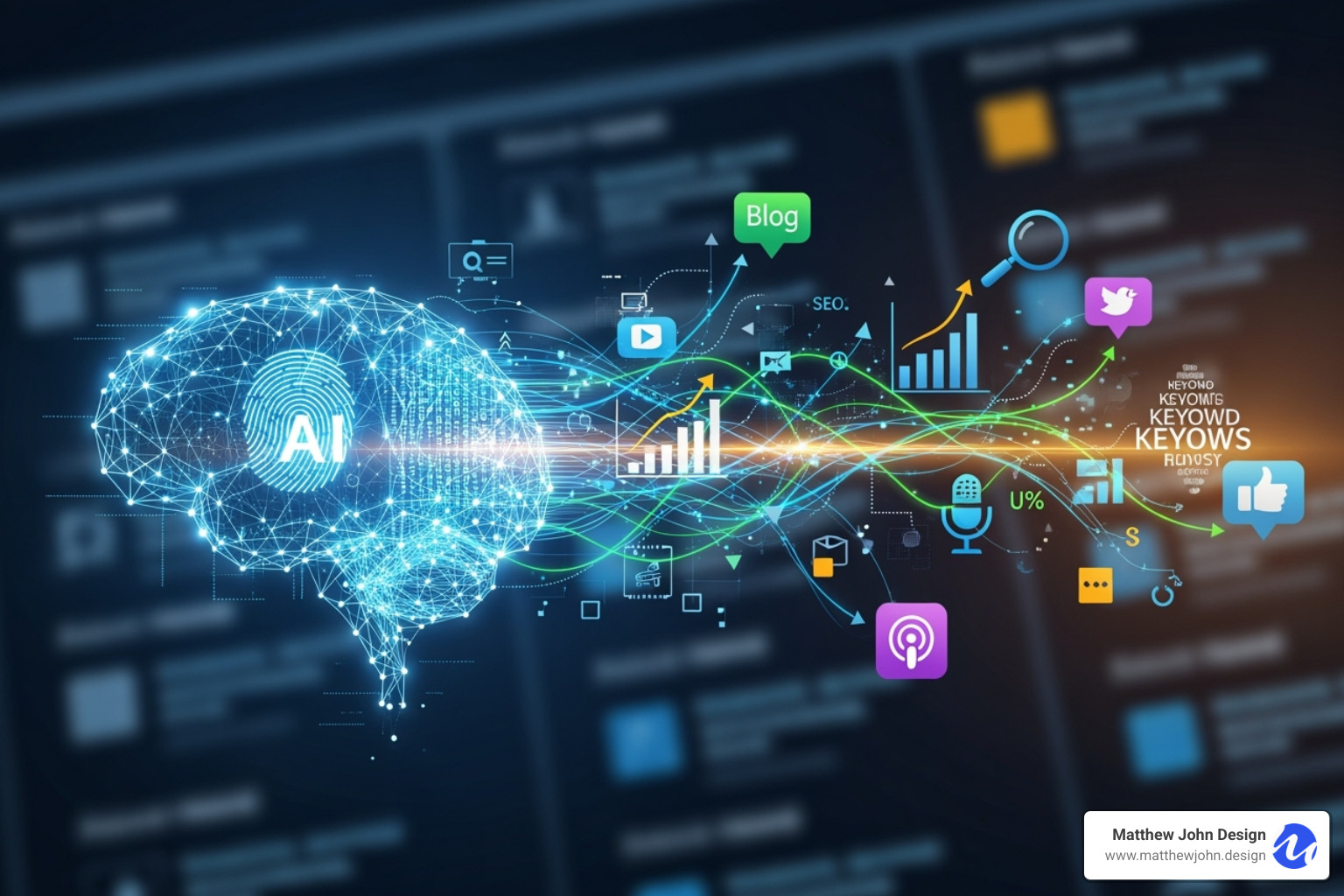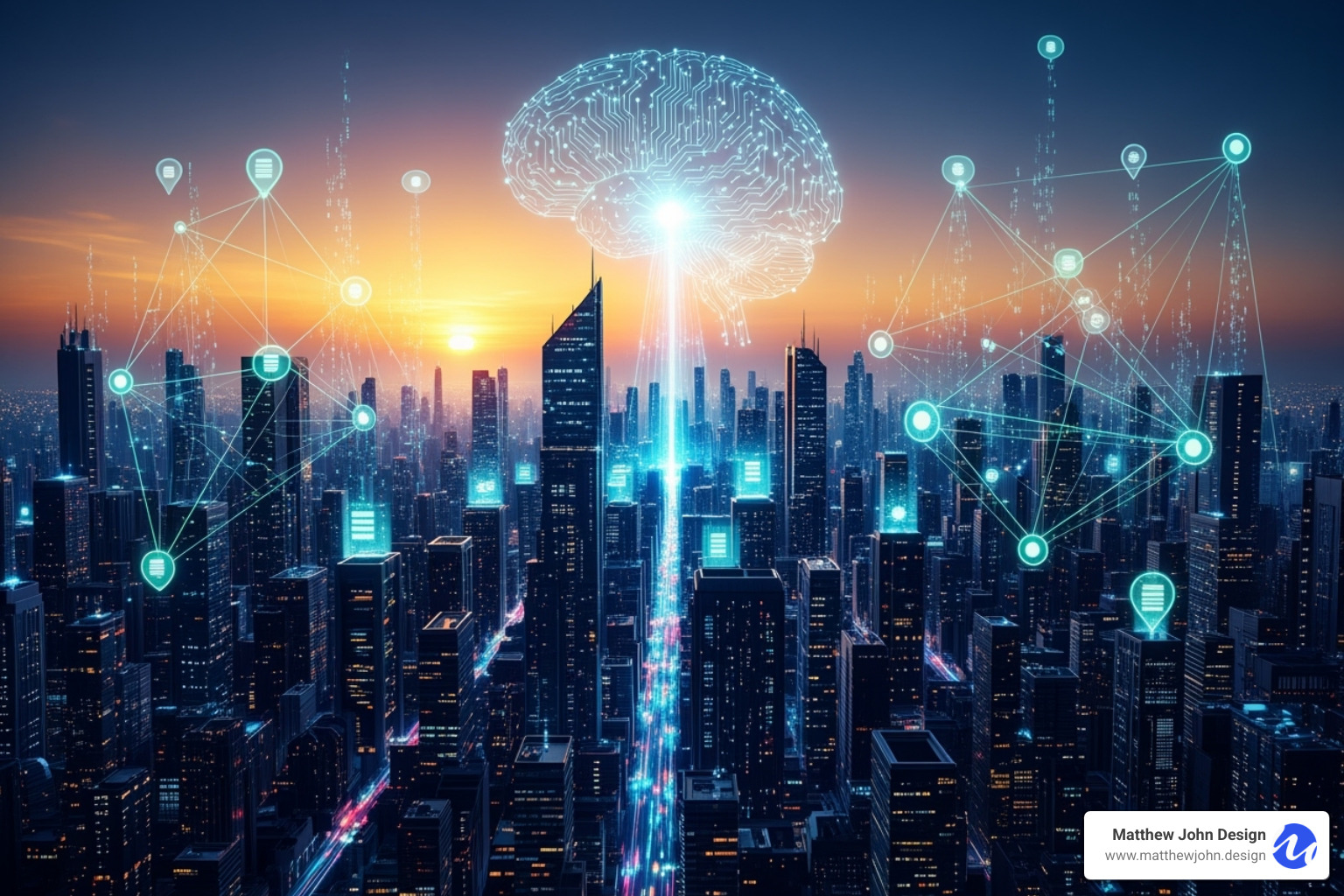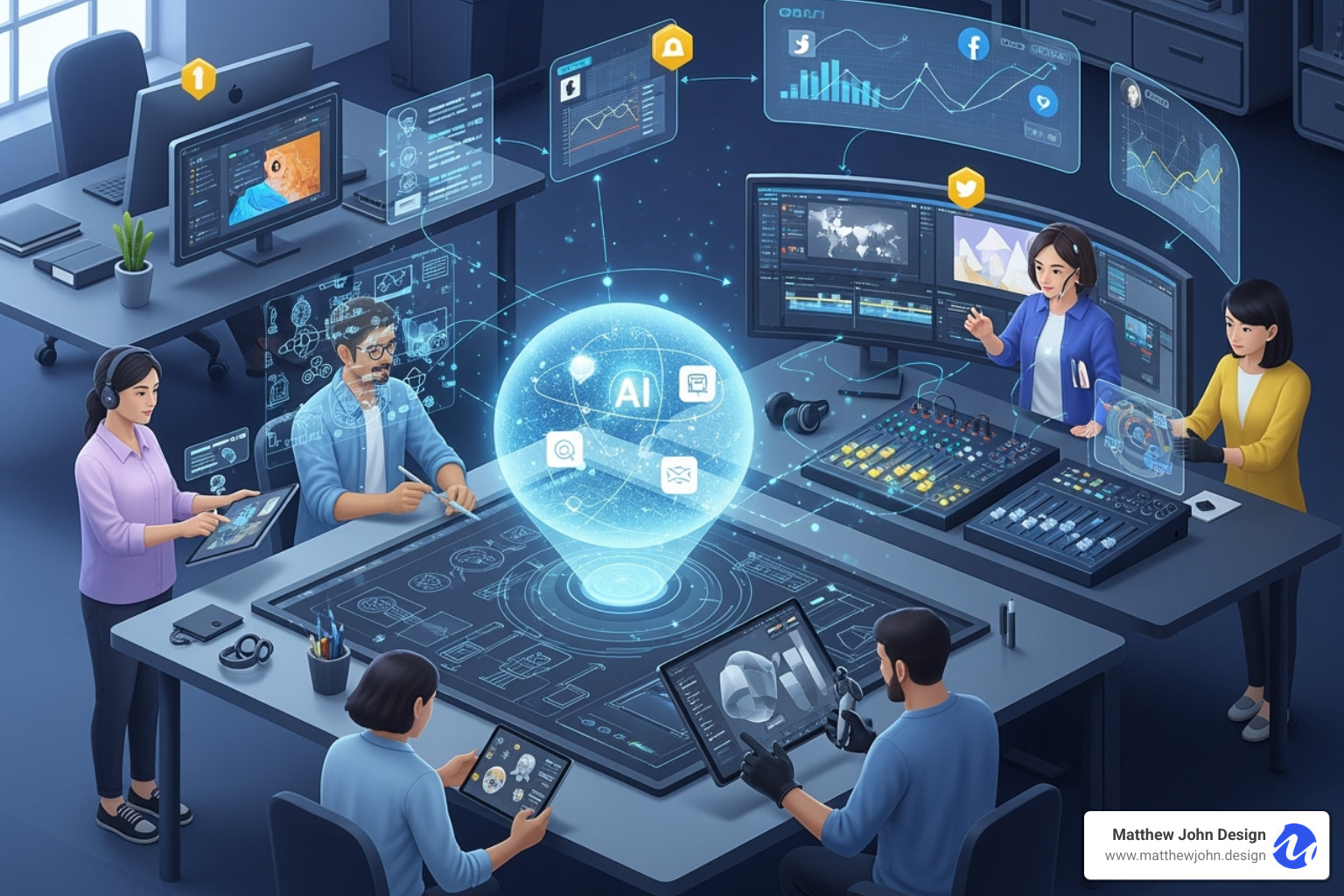Any information contained on this Website is not legal advice and should not be treated as such. You should always contact an attorney for help with your specific legal needs and issues. We may also earn a commission when you click links to our partners and purchase goods or services. For more information, read our Disclaimers Policy.
Understanding AI-Driven SEO Content Creation
AI-driven SEO content creation uses artificial intelligence to create, optimize, and distribute online material to improve search engine rankings. Think of it as having a super-smart assistant for all your content needs.
Here's what it means:
- AI for Research: Tools that dig through data to find the best keywords, trending topics, and audience needs.
- AI for Creation: Software that helps write outlines, first drafts, and even full articles, making the process faster.
- AI for Optimization: AI that ensures your content is perfectly tuned for search platforms, catching things humans might miss.
- AI for Strategy: Using AI to analyze what's working so you can make smarter content decisions.
As the internet evolves, AI is making content creation more precise and effective. Over 75% of marketers use AI tools, and about 19% of businesses use AI for content generation. This shift accelerates content delivery and reduces costs, dramatically speeding up tasks that traditionally take hours, like writing a 500-word blog post.
But it’s not just about speed; it’s about creating better, more relevant content that connects with your audience and stands out.

Basic ai-driven seo content creation vocab:
What is AI-Driven SEO Content Creation and Why Does It Matter?
At its core, AI-driven SEO content creation leverages artificial intelligence, like Large Language Models (LLMs) and Natural Language Generation (NLG), to improve the entire content lifecycle. LLMs are trained on vast datasets to process human language, while NLG converts data into readable text. Combined with SEO, these technologies help create and optimize content for better search engine rankings.
This matters because traditional content creation is slow and expensive. A 500-word blog post can take 4 hours, and outsourcing a 1,500-word article can cost upwards of $175. AI streamlines this process, offering significant time savings, reduced costs, and increased productivity. By generating ideas, outlines, and drafts at high speed, we can scale content production, maintain consistency, and gain a competitive edge.

How AI Improves the Content Process
AI is a practical tool that improves the content process in several key ways:
- Keyword Research: AI tools analyze massive amounts of data to identify high-value keywords, predict search trends, and uncover long-tail keywords that human researchers might miss.
- Competitor Analysis: AI can quickly scrutinize what our competitors are doing well in search results, allowing us to identify content gaps and understand their strategies.
- Topic Clustering and Ideation: AI suggests trending topics and related ideas that resonate with our target audience by analyzing search queries and social media. This helps build topical authority.
- Outline Generation: Once we have a topic, AI can quickly generate detailed outlines with headings and sub-points, structuring articles for optimal readability and SEO.
- First Draft Creation: AI can produce initial drafts of articles and blog posts. While these drafts require human refinement, they significantly cut down on initial writing time.
- Data Analysis and User Intent: AI algorithms are adept at understanding the context behind search queries, allowing us to tailor content that directly addresses user intent.
The Tangible Benefits for Your Business
The adoption of AI in marketing is widespread, with over 75% of marketers using AI tools and 19% of businesses generating content with it. This trend highlights tangible benefits for businesses:
- Scaling Content Production: With AI, we can produce a larger volume of high-quality content in less time, maintaining a consistent publishing schedule across multiple channels.
- Maintaining Consistency: AI helps maintain a consistent tone of voice, style, and messaging across all content, ensuring a unified brand presence.
- Gaining a Competitive Edge: By efficiently producing optimized and relevant content, we can outrank competitors, capture more organic traffic, and position ourselves as industry leaders.
By leveraging ai-driven seo content creation, we can save time and money while improving the quality and effectiveness of our digital marketing efforts. This is particularly relevant when we're optimizing Webflow sites for higher conversions.
Google's Verdict: Using AI Content Without Getting Penalized
A common question is Google's stance on AI-generated content. Fortunately, their position is clear and pragmatic. Google's official guidance emphasizes quality and helpfulness. Using AI is not against their guidelines, provided it's not for creating spammy content to manipulate search rankings.
Google rewards high-quality content regardless of its origin. Their systems are designed to identify and promote original, helpful content, whether human-written or AI-assisted. The focus is on user experience and value, aligning with E-E-A-T principles.
Systems like SpamBrain identify spam content, regardless of how it's created. Google has long dealt with mass-produced, low-quality content. Their helpful content system prioritizes content made for people, not search engines. The takeaway is simple: low-quality, manipulative AI content will be penalized, while helpful, well-crafted content is rewarded.

Understanding E-E-A-T in the Age of AI
E-E-A-T (Experience, Expertise, Authoritativeness, Trustworthiness) is Google's framework for evaluating content quality and credibility. In the age of AI, E-E-A-T is crucial, especially for Your Money or Your Life (YMYL) topics where accuracy is paramount.
- Experience: Does the content demonstrate first-hand experience? Human input is indispensable here, as AI cannot experience things.
- Expertise: Is the content produced by someone knowledgeable? We ensure our content is informed by genuine expertise.
- Authoritativeness: Is the creator or website a recognized authority? This is built over time through consistent, high-quality content and external validation.
- Trustworthiness: Is the content accurate, transparent, and truthful? This involves fact-checking, citing sources, and being transparent about how AI is used.
For ai-driven seo content creation, our approach is to leverage AI to improve our ability to demonstrate E-E-A-T, not bypass it. This means using AI for research and optimization but always infusing content with our unique experience and verifiable expertise. For our Webflow clients, this translates into optimizing blog posts to clearly convey E-E-A-T signals, a core part of our Webflow blog optimization services. We also recommend adding accurate author bylines and clear disclosures about AI's role.
Avoiding Common Pitfalls and AI-Generated Spam
While powerful, AI has pitfalls if used without human oversight, which can lead to:
- Low-Quality Content: AI can produce generic or repetitive text and sometimes "hallucinates" facts or sources.
- Manipulating Search Rankings: Mass-producing shallow content for SEO violates Google's spam policies and risks penalties.
- Lack of Originality: Over-reliance on the same tools can lead to unoriginal content. Human ingenuity is crucial for unique angles.
- Factual Inaccuracies: AI-generated content can contain errors, harming your reputation.
- AI Hallucinations: These are plausible-sounding but false statements that require human fact-checking.
Google uses systems like SpamBrain to identify and demote spam. Our goal is to use AI as a powerful assistant to create genuinely helpful content, not to cut corners.
The Human + AI Workflow: A Step-by-Step Guide
To get the best of AI speed and human creativity in ai-driven seo content creation, we use a "human-in-the-loop" model. This partnership uses AI as a fast, data-crunching assistant for research and drafting, guided by careful prompt engineering. Human experts then provide strategic thinking, unique insights, and quality assurance. This approach isn't just about speed but about working smarter. At Matthew John Design, this integration helps us build scalable Webflow sites that make content management easy for marketing teams.

Step 1: AI-Powered Research and Outlining
Our content process begins with AI-powered research. For audience needs analysis, AI sifts through search queries, social media, and forums to identify user questions and problems, helping us pinpoint valuable topics. AI also assists with search intent mapping, determining the 'why' behind a search. This ensures our content directly answers user needs, improving engagement and rankings.
With the topic and intent defined, AI generates detailed content briefs with headings, keywords, and competitor analysis. It also helps structure articles with logical headings (H1, H2, H3) for readability and SEO. Finally, AI is great at identifying semantic keywords—related words and phrases that add depth to your content, showing Google you've covered a topic thoroughly. These steps help us create a strong, data-backed outline using a comprehensive SEO content creation tool.
The Critical Role of Human Oversight in AI-Driven SEO Content Creation
While AI creates impressive drafts, our human touch transforms them into great content. We serve as the editor, fact-checker, and storyteller.
Our first task is fact-checking and ensuring accuracy, as AI can pull outdated or incorrect information. We also handle editing for brand voice and tone, fine-tuning the text to match your brand's unique personality.
AI lacks original thoughts and emotions, so we add unique insights and experience. We infuse content with our perspectives and real-world examples to boost E-E-A-T. We also use storytelling and emotion to connect with readers on a level AI cannot replicate, adding anecdotes and empathy to keep them engaged.
We focus heavily on ensuring originality. We extensively edit and expand upon AI output to make sure your content is unique, and we always run plagiarism checks. Finally, we carefully review AI output for flow, readability, and grammar, as a human editor's eye is essential for polishing the final piece. This oversight lifts raw AI output into high-quality, authentic content that connects with your audience.
Key Ethical Considerations for AI-Driven SEO Content Creation
Using AI in content creation requires ethical considerations. At Matthew John Design, we prioritize transparency and responsibility.
First is transparency with your audience. While not required by Google, we believe it's good practice to be open about AI's role. However, we don't recommend listing AI as an author, as it removes the human accountability valued by E-E-A-T.
Next is avoiding plagiarism. AI tools learn from existing data, so we always use plagiarism checkers and add sufficient human editing to ensure originality. We also watch for misinformation risks, as AI can reflect biases from its training data. Our rigorous fact-checking process prevents inaccurate content from being published.
Finally, we consider data privacy. When using AI tools, we ensure full compliance with all data privacy regulations. For more on this topic, there are great resources discussing the broader ethical concerns in AI content creation.
The Future is Now: Advanced AI Applications and Trends in SEO
The world of search is changing rapidly, with AI-driven SEO content creation leading the way. What was once science fiction now reshapes our approach to online visibility.
AI Overviews (formerly SGE) are now in over 100 countries, providing summarized answers in search results. This makes creating citation-worthy, trustworthy content more important than ever, as AI systems increasingly rely on reliable sources.
Generative Engine Optimization (GEO) is an emerging field focused on structuring content so AI models will reference it, essentially creating content that AI wants to quote.
Voice search optimization is also growing. AI-powered Natural Language Processing helps us optimize for conversational queries, so content must sound natural and answer questions directly.
Other key trends include hyper-personalization, where AI creates unique content experiences for individual visitors, and visual search optimization, which involves properly tagging images so AI can recognize and find them.
These trends show that ai-driven seo content creation is fundamentally changing online visibility. Our work with Webflow's component-based systems positions us perfectly for these changes, especially when implementing advanced strategies like programmatic SEO & Webflow.
Using AI for Content Repurposing and Accessibility
AI is also a powerful tool for repurposing existing content, making it work harder across multiple channels.
Summarizing long-form content is effortless with AI. It can turn a long guide into bite-sized summaries for emails or social media, saving hours of manual work.
Creating social media posts from articles is another game-changer. AI can generate multiple platform-specific variations from a single blog post.
Generating video scripts from articles opens up new possibilities, which is valuable for our SEO writing and video services. Webflow only supports background videos up to 30 MB and doesn't host larger files. For those, we recommend third-party solutions like YouTube, Vimeo, or Vidzflow.
AI also helps with improving readability and accessibility by analyzing scores, suggesting simpler language, and recommending better structures. It can also assist in adding structured data (schema markup) to help search engines understand your content and generate rich snippets.
Frequently Asked Questions about AI in SEO
Let's address some common questions about AI and SEO.
Is AI-generated content bad for SEO?
No, AI-generated content is not inherently bad for SEO. Google's priority is helpful, high-quality, and original information, regardless of how it's produced. Content that provides genuine user value and aligns with E-E-A-T principles can rank well. The issue isn't AI, but its application. Low-quality, spammy content created to manipulate rankings will likely be penalized. However, when used wisely within an ai-driven seo content creation strategy, AI is a powerful tool.
Can AI completely replace human content creators?
No. Think of AI as a co-pilot, not a replacement. AI excels at automating tasks, speeding up research, and generating first drafts. However, it lacks human creativity, critical thinking, empathy, and lived experiences. The best content combines AI's efficiency with human insight, voice, and emotional connection. Human oversight is crucial for fact-checking, brand alignment, and storytelling. AI augments human capabilities; it doesn't replace them.
How do I ensure the originality of AI-generated content?
Ensuring originality is key to ai-driven seo content creation. Start with specific and unique prompt engineering to guide the AI away from generic output. Always use a reputable plagiarism checker to confirm your content is distinct. Most importantly, add personal anecdotes and unique data, such as case studies or proprietary research that only a human can provide. Finally, treat AI-generated text as a first draft that requires substantial human editing. Rewrite, expand, and inject your distinct voice to transform it into high-quality, original content.
Conclusion
Our exploration of ai-driven seo content creation shows how AI can transform our work, making it faster and more effective. The key takeaway is that AI doesn't replace the human touch—it amplifies it.
Google's message is clear: quality and helpfulness are paramount, regardless of origin. The secret is synergy—using AI for heavy lifting while human creativity and oversight ensure accuracy, originality, and value. AI brings efficiency; humans bring the heart. By combining AI's data power with human insight and experience, we create content that doesn't just rank well—it helps people.
At Matthew John Design, we help businesses find this balance. Our approach to building scalable, component-based Webflow sites mirrors this philosophy. We create systems that are powerful yet human-friendly, allowing your marketing teams to manage content efficiently.
Our SEO services also emphasize this human-AI partnership. We use AI to research and optimize, but we always infuse content with genuine expertise. The future of content isn't about choosing between humans and machines; it's about strategic adoption. By future-proofing your content strategy with this balanced approach, you're positioning your business to thrive as search evolves.
Ready to harness this powerful combination for your business? We'd love to help you open up your full potential in organic search.

